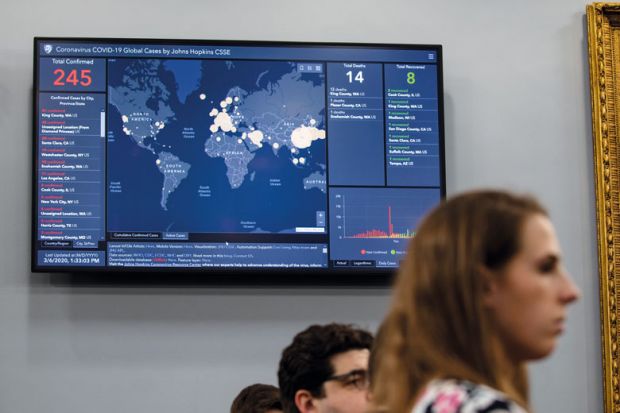The Covid-19 dashboard at Johns Hopkins University, which served as a vital public health tool during the pandemic, demonstrates the crucial role that research universities can play during global crises, according to its creators.
The Johns Hopkins University School of Medicine’s Coronavirus Resource Centre (CRC) ceased collecting and reporting coronavirus data on 10 March – three years after the global dashboard was created by Ensheng Dong, a graduate student in engineering, and his adviser, Lauren Gardner.
The CRC would go on to gain more than 2.5 billion website views and provide the public, journalists and policymakers across the world with reliable, real-time information and expert analysis on the spread of Covid.
In the earliest days of the pandemic, the university saw a gap and jumped in, Lainie Rutkow, the CRC project lead and vice-provost for interdisciplinary initiatives at JHU, told Times Higher Education.
“For everyone involved, this 24/7 effort was developed and maintained on top of their typical work responsibilities,” she said.
The dashboard immediately grew in popularity, and the university’s Applied Physics Lab joined the team to assist in scaling the dashboard’s infrastructure to meet the global demand for real-time information.
Within weeks, the CRC was born – pairing the powerful data tools of the global dashboard with experts from JHU who could make sense of the data for the public, and provide guidance and analysis.
Interdisciplinary collaboration was key and “because they host such a broad range of expertise, universities are uniquely positioned to engage in interdisciplinary efforts”, said Ms Rutkow.
“The CRC demonstrates the role that research universities like Johns Hopkins can – and, we believe, should – play as a partner to governments in times of global crises.”
With no more home-testing results and many areas reducing their publication frequency, Mr Dong told THE that the dashboard would no longer be as helpful.
He said JHU had filled a gap between the information provided by the World Health Organization and that of local government. “The university played a very critical role because we have a smaller group, we have the flexibility and the freedom to decide things very quickly, so when we started to track the data we filled that gap between the WHO and the government.”
Mr Dong was just 30 and in his first semester in the department of civil and systems engineering – working on a thesis whose precise subject is yet to be decided, such has been his commitment and workload on the dashboard – when he launched the first version of the dashboard in January 2020.
He did so partly to collect data for his PhD thesis, but also out of concern for his friends and family back in his native China, who had told him of the growing threat.
That first draft – which took him about eight hours to build – was released on Twitter at the same time as the US reported its first case and the city of Wuhan was locked down by Chinese authorities.
The team had to handle pressure, both from government checking that the data was accurate, and from users wanting more frequent updates, while navigating debates on the design and format of the dashboard, and even geopolitical tensions in deciding which countries to allocate certain cases and deaths to.
Mr Dong said the highlight was receiving feedback from users, including hospitals, which were able to manage their workloads because they knew how many cases were in their area.
The CRC was used extensively by world leaders, and Mr Dong said he felt great pride to see US president Joe Biden announcing data clearly taken from the dashboard, and receiving praise from former German chancellor Angela Merkel.
The JHU map tracked hundreds of millions of Covid-19 cases, but never Mr Dong himself.
“That’s a miracle because in our team everyone got Covid except me,” he said. “I…designed the dashboard but I was never a dot on the dashboard.”




